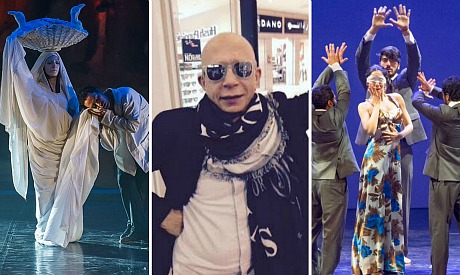
A Sculptor’s Dream by Lebanese director and choreographer Walid Aouni was recently performed at the Cairo and Alexandria opera houses.
Though it is a returning work, which premiered in 2003 and throughout the years went through some modifications, Aouni never fails in surprising us with a fresh eye on art, theatre and dance.
Fusing Egyptian history with contemporary choreography techniques seems to be his hallmark.
Al-Ahram Hebdo (AH): You left in 2011after many years of working at the Cairo Opera’s stage. What was behind your decision to return to the opera now with a work that first saw light over a decade ago?
Walid Aouni (WA): I’m returning in response to the opera’s chairperson Ines Abdel-Dayem, who expressed hope to revive the repertoire of the Egyptian Modern Dance Theatre Company, which I founded in 1993. Abdel-Dayem is particularly interested in presenting performances linked to Egypt’s history and culture. Last year, she invited me to stage Women of Kassem Amin (Nessaa Kassem Amin), a dance performance tackling the emancipation of women. This year, it was time to bring back A Sculptor’s Dream, a work which focuses on the life and creativity of Egyptian sculptor Mahmoud Mokhtar.
AH: This is not the first time this performance has been staged. Why is it that each time you return to it, you give it a new creative flair?
WA: Since 1990, when I made Egypt my home, I have developed a special relation with Mahmoud Mokhtar. This time I wanted to get closer and experience the country’s culture and its leading figures. I looked into Egypt’s Renaissance, represented also by Mokhtar, who has revived the ancient art of sculpture.
In 1991, I had an opportunity to work with the Cairo Opera Ballet Company, a troupe for which I choreographed Three Nights of the Sphinx, a performance that included a small scene presenting Mokhtar. But that was not enough. I wanted to approach him even more. However, it took me a decade to develop a choreography inspired by sculptures. This is when Mahmoud Mokhtar and the Khamaseen Wind emerged in 2003, staged by the Egyptian Modern Dance Theatre Company. Through Mokhtar’s sculptures, the performance evoked the key figures of the Egyptian Renaissance (or Nahda).
Once again, I revisited Mokhtar in a show prepared for the celebrations of Egypt Arts Centenary back in 2011.
Finally, in 2015, I created yet another version with revised choreography and gave it the title of A Sculptor’s Dream, which was performed at the closing of the 20th edition of the Aswan International Sculpture Symposium. In it I stressed the continuity of the various generations of sculptors from ancient Egypt to the present day. This is the choreography that was presented during the last performances in Cairo and Alexandria.
AH: You have spent over 25 years of your life in Egypt. Many of your works are inspired by artists. Even before your arrival to Egypt, artists already played an important role in your work…
WA: Indeed. In 1979, in Brussels, where I worked with my company Tanit Dance Theatre, I choreographed a performance based on the paintings by Gibran Khalil Gibran. It was my very first work as a choreographer.
At the time I was living in Belgium and felt very nostalgic towards my home-country Lebanon. I thought a lot about the great universality of the works by artist and poet Gibran. I was proud to reveal a painter in him to the European audiences.
AH: Now that you are a director, choreographer, but also a painter, you continue to fuse the many artists in your performances. Now, you give a lot of importance to the Egyptian artists. Tell us more about it please.
WA: In the early years of my career in Egypt, I presented the Fall of Icarus (1993), a performance which generated a lot of controversy. I had an impression that the dance theatre will be never appreciated in Egypt.
I went to Lausanne, Switzerland, where I worked alongside Maurice Béjart. He advised me to immerse into the history and culture of Egypt.
Upon my return to Egypt, I decided to study the country’s culture. This allowed me to create works such as Coma (1995) based on Naguib Mahfouz’s trilogy The Last Encounter (1996), inspired by renowned painter Tahia Halim, and The Desert (or The World) of Shady Abdel Salam (1997), which honoured the renowned filmmaker.
I see that there is a great cultural wealth which has been passed from our ancestors to the contemporary artists. And the time came for Mahmoud Mokhtar…
There was also a performance of Banat Bahri (2005) inspired by the famed painting by Mahmoud Said and staged during the Centenary celebrations.
In fact, many artists inspired me, and 11 of them were reflected in my performances. In my work, you will find many Egyptian artists, graduates of the Fine Arts department: apart of Mahmoud Mokhtar, there is also sculptor Gamal El-Sagini, architect Hassan Fathy, painters Hussein Bicar, Hamed Nada, Abdel Hadi Al Gazzar, Adham and Seif Wanly, father of Egyptian modern art of puppetry Nagy Shaker, graphic artist Al-Hussein Fawzi, as well as versatile artist Salah Abdel Kerim.
AH: Who will be the next Egyptian artists to inspire your new choreography?
WA: I would love to explore paintings by Hamed Nada. His women have fragile bodies and very dynamic positions. I see them dancing.
I am also very interested in the work of Adam Henein. There is a lot of inspiration in his abstract or figurative sculptures that can be transformed onto the on-stage scenes and dance.
Paintings by Farouk Hosny are also yearning for a rich scenography. In my mind, I can see them associated with universal musicians such as Bach or Wagner.
Ahram
Leave a Reply
You must be logged in to post a comment.